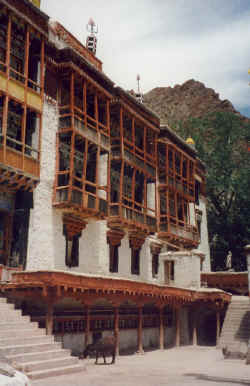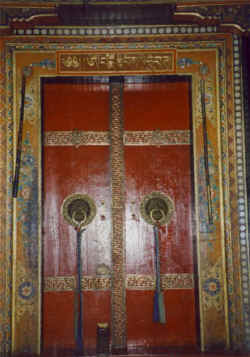MyHimalayasimpressions from |
|
|||||||
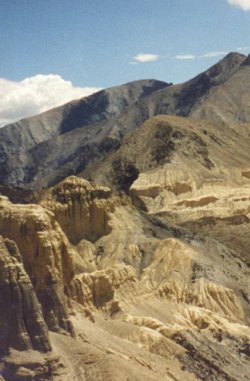
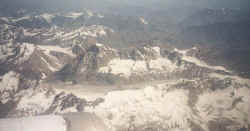
Enormous glaciers beneath us shortly before Leh, tall summits at the horizon
(sadly not in the picture) must the giants of the Pakistani Karakorum.
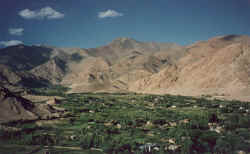
Green valley of Leh in the mountainous desert.
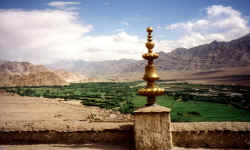
Indus valley from top of one of the many monasteries.
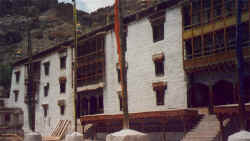
Hemis - largest monastery that is well-known for its dance-festival in
summer.
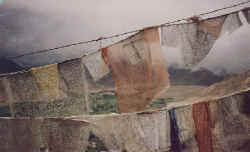
Prayerflags on the top of Namgyal peak.
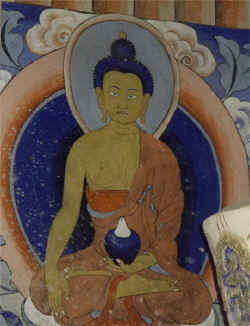
Buddha Sakyamuni, the historical Buddha, is often depicted in rural painting and
statues.

Green sidevalley, at its end lies the monastery Traktok
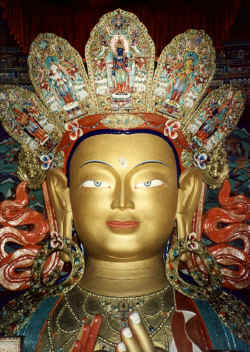
Large statue of Maitreya at Thikse monastery.
Indus Valley: Leh and Indus Valley
Arrival in Leh
The flight from Delhi to Leh leaves at 6 a.m., which means I have to get up at 4 o'clock. I meet the other members of the group in the taxi which takes us the airport. We're only three; I'm surprised that they organise treks for such small groups. Anyway, Manuel and Gabi are both from Zurich and seem to be nice. They've never been to India before but have travelled in other parts of the world. Hopefully this will make travelling with them easier, as they won't complain when things aren't as perfect as they are in Switzerland. The check-in in Delhi goes relatively smooth. We walk to the runway, where an official points to the airplane we have to take.
At half past six we're in the air. When one hour later the stewardess tells us to get ready for landing I'm a bit worried. This is supposed to be a direct flight to Leh and we haven't crossed the Himalayan range yet. Did I get on the wrong plane? Luckily not; it turns out we are making a quick stop in Jammu at what looks like a military airport. Another civil airplane is waiting there; a mechanic connects the two airplanes with a huge hose while others with big screwdrivers do something on our plane. Everything seems unusual, but I'm sure they know what they're doing. We wait for 45 minutes; it's hot, it's humid, you can't move and nothing happens. The captain gets out, has a big, angry discussion with one of the officials, points to the cockpit a few times, the hose is disconnected and then connected again. We wait. And sweat. Half an hour later we finally take off for Leh.
Delhi was foggy and cloudy, offering no nice views. The fog is gone; the area around Jammu is totally flat - green rice fields stretch as far as I can see. Further north almost all the clouds have disappeared, and far away I see the beginning of a small mountain range. Many rivers begin at the southern side of the hills, these not very high hills are the first barrier for clouds that they can't pass and it rains. On the northern side it's drier, the sudden change of colours from green to brown.
Five minutes later snow-capped mountains appear; another five minutes later we're right above the highest mountain range on Earth. Himalaya means 'abode of snow', a fitting name. Huge glaciers wind themselves down high valleys, they look more like flowing rivers then the (relatively) static blocks of ice they really are. On the horizon three summits can be seen which are so high that they really stand out. I suppose they are K2 (8611 m), Broad Peak (8047 m) and Gasherbrum (8068 m). They are all in northern Pakistan, therefore the border must be close. This is why taking pictures is forbidden, though I'm able to take a few before the stewardess tells me to stop. I've heard of tourists whose films were taken out of the camera. I'm lucky and can keep my film, but I decide not take any more pictures, which is a pity, because the changes in landscape are incredible.
A few minutes later we've crossed the range. It looks like the Tibetan high plateau now, only the highest peaks are snow covered on the top, the dominant colour is different kinds of browns, reds and greys. From fields to glaciers to desert. What's next? As soon as we approach the Indus valley, small strips of green are visible. They follow glacier creeks in narrow valleys and look like oases in the otherwise barren landscape. The broad, fertile Indus valley is in front of us, we're almost in Leh. I can make out a few monasteries and villages, but the strategic importance of Ladakh can be seen more easily. There seem to be more army barracks than normal buildings, especially around the airport.
Ladakh lies in the most north-western part of India, north of the Himalayas. It borders Pakistan to the west and Tibet (which is occupied by China) to the north-east. La is Tibetan and means 'pass', Ladakh means 'land of high passes'. The name says a lot about the region, the only way to get into this area is over a couple of high passes. It's one of the highest areas inhabited by humans. The average height of the valleys is 3'500 m, but 99,5% of the region is unsuitable for settlements. To the north is the Ladakh range, south of the Indus valley is the Zanskar range, further south follows the massive Himalayan range. To the east the land becomes flat and turns into a high plateau called Changtang, which stretches over the western part of Tibet. Only nomads and their cattle manage to live in this harsh climate where temperatures fall below -25øC during the winter. Most of the population lives near creeks with glacier water and work as farmers. Agriculture is possible up to an altitude of 4'500 m.
The first thing I notice when I'm out of the airplane is that the climate is great, a true blessing. It's about 25° C, sunny and there's a light breeze. It's warm and dry; after the humid heat in Delhi it feels good to be here in Ladakh.
Our hotel, Hotel Omasila, is a bit outside Leh in Changspa. It lies between green barley fields and apple trees and has a nice garden. The altitude causes problems to most tourists for a day or two. At 3'500 m the air is thinner, which can lead to headaches, insomnia and dizziness. Therefore it's recommended to rest for at least one day. I know that. And the garden would be the perfect spot for a nap. Do I rest? No, of course not. While I'm here I want to see as much as possible, after lying on the bed for 20 minutes I can't resist anymore and just have to go and explore Leh.
It was once the capital of the kingdom of Ladakh and has a population of 10'000, which makes it by far the largest city in the region. Many caravan routes cross here, Leh used to be a big trading place and meeting point for different cultures and races. Leh means 'oasis', and it's easy to imagine that after the hard and strenuous journeys this big village really must have been an oasis for the exhausted traveller. The centre of city was the market place, where nomads traded wool for carpets, Tibetans brought tea and salt in exchange for brocade from India and Persian merchants sold goods from the orient. In the 17th century Leh became the residence of the king, and since then it's been the economic and administrative centre.
The atmosphere is very relaxed, shop owners don't hassle me (for too long) when I walk by their shops, traffic is light and it's not too crowded. The mix of different cultures is amazing, the more persistent shop owners have Arabic faces (Muslims); there's quite a large number of Hindus from the south and of course many Ladakhis with Tibetan and Mongolian faces. The mosque was built when the king asked for assistance to fight back the Tibetan army. The Kashmiri agreed to help him on the condition that he converted to Islam (in addition to some cash, of course). Handicraft is mostly sold by Hindus and Muslims from Kashmir, Ladakhis sell jewellery. The different races and cultures seem to get along well. Many of them have lived here for a long time (only Hindus came here in the last decade), peacefully most of the time. But in 1992 violence broke out, Buddhists set Muslim houses on fire and forced them to move to other villages. Now things are calm.
Along the main road farmers, mostly women, sell produce - turnip, tomatoes, radishes, beans, peas, potatoes, carrots - and fruit - apples and apricots.. It's surprising that all this grows at this altitude. I walk around in the old part of Leh which reminds me very strongly of the not-yet-destroyed old parts of Lhasa, the capital of Tibet. Whitewashed houses, several stories high are built next to each other, small alleys go steeply up the hill. The old palace dominates the whole city. Captains of the Indian army, whose invasion marked the end of the kingdom, lived in the palace; before that it was the residence of the Namgyal dynasty. It's dilapidated now. Further up are some monasteries and on top of the hill is the ruin of an old castle. It would be a long walk up there and since I start to notice the effects of the altitude, I postpone climbing that hill for later.
Even after having had a short rest at the hotel I'm still tired. My travel book says something about an old chorten, a Buddhist monument, in Changspa, just a five-minute walk from the hotel. It should be easy to find, but I can't find it and just follow the road for a bit. At the end of the road I see the Shanti Stupa on top of a hill. Now I know where to go. Steep stairs lead up to it and I know I shouldn't go up there before I'm properly acclimatized. But I can't resist it. Now I really notice the lack of air up here, breathing is much more difficult than at sea level. I have to sit down a few times, which is a good opportunity to enjoy the great view. Leh and the Ladakh range are to my left, ahead is the wide Indus valley, behind are a few high mountains which are followed by the Zanskar range.
The Shanti Stupa was built only a few years ago and is financed by a rich Japanese Zen-Buddhist association. Its goal is to deepen the co-operation and understanding between the different schools of Buddhism. Interestingly the Dalai Lama didn't take part in the opening ceremony, because he thought that Buddhists and Muslims should get along first. On the way back to the hotel I see the chorten I was looking for before. It seems really old and has an unusual style of architecture. It's about a thousand years old, and with its sixteen corners resembles a pyramid. It reminds me of the Stupa in Gyantse, Tibet, but this chorten can't be walked on. Earlier the steps might have served as a place for Buddha statues. A small shrine nearby shows some statues and paintings. It's a beautiful, quiet spot, nobody's here.
There's a small river nearby and the laughter of the women (and some men) doing their laundry can be heard far away. People here are happier than people in Delhi; they greet you, laugh at you and seem to be more open. But maybe I'm wrong and it just seems that way because I am more comfortable and happy here than in Delhi.
I've done too many things this afternoon and have a small headache. I'm glad to get back to my nice room, and after a great dinner I fall asleep almost instantly.
Trakthok, Hemis, Thikse
I sleep surprisingly well and have absolutely no problems with the altitude. Our guide Phunchok will show us around in the Indus valley for the next two days. On today's programme are three monasteries in the eastern part of the valley. Getting there involves some driving, but that's exciting. The drive up the valley is beautiful. The fertile area is a great contrast to the brown of the desert, the white of glaciers and the blue of the sky. The morning sun intensifies the colours and makes it even more breathtaking. Every once in a while we drive past barren areas fenced with barbed wired military zones. The road leads eastwards for two hours, then we take a left to drive up the valley to where the village Saki and the Trakthok monastery are.
If you don't know anything about Buddhism, don't consider coming to Ladakh! You wouldn't understand the people and their culture. The monasteries and statues may still strike you with their beauty, but you won't understand their meaning, which will probably leave you feeling unsatisfied. Although there are other religions in Ladakh, Buddhism is the one that has imprinted people's lives in the area for almost two thousand years.
In the many centuries since the founding of Buddhism, different interpretations of Buddha's teaching have led to two systems. For followers of Hinayana, 'the small vehicle', the goal is to reach their own salvation and to go to Nirvana. People in northern India, Tibet and Mongolia believe in Mahayana, 'the big vehicle'. They pay more attention to the compassion often mentioned by Buddha and try not only to reach Nirvana, but to help others reach Nirvana, too. A good example is Avalokiteshvara, whose statue can be found in many monasteries. He could have gone Nirvana, but decided to come back to earth because he couldn't bear the fact that so many people are miserable and won't find enlightenment. Often he has eleven faces to see where his help is needed and a thousand hands to actually help. Buddhists think that the Dalai Lama, the spiritual and political leader of Tibet, is the embodiment of Bhodisatva Avalokiteshvara.
Before Buddhism arrived in Ladakh, people believed in a natural religion called Bön. When Padmasambhava, an Indian master of Buddhism, came to Ladakh, he faced the opposition of the old priests and shamans. So he just incorporated parts of the Bön religion into Buddhism. The legends say that Padmasambhava fought with the Bön demons, was victorious and the demons became protectors of Buddhism, which means the same as the sentence before. Buddhists have perfected the art of telling facts in an easy to understand way. This also goes for statues, dance festivals or paintings: They are just symbols and convey a deeper message. This mix between the colourful old Bön, its gods and the purely philosophical Buddhism led to a new form of Buddhism, often called Tibetan Buddhism.
After the hours I've spent over books, I'm really excited to see all this for real. The side valley of Saki is very long, it takes more than half an hour to reach Trakthok, which is built on the upper end of the valley. It was founded by the famous scholar Padmasabhava, who grew up in India and later spread Buddhism in the Himalaya region. He's often referred to as the founder of Tibetan Buddhism. During one of his many trips, he meditated in a cave at Trekthok, which means 'cave ceiling'. This cave is now the central room of one of the very few cave monasteries in the area. Though it is small, it looks great because it is built very close to the rock. This monastery belongs to the Nyingmapa sect, which is the oldest sect and was also founded by Padmasambhava. They practise tantric and occult rituals and used to live in isolation. Only very few people are part of this sect these days, and Trakthok is their only monastery in Ladakh. They are said to have special abilities, but are not allowed to show them in public or even speak about them. I as an unknowing tourist don't see any differences to other monasteries or monks. It's really cold in the cave, its walls are black from the lamp-black of butter lamps that are lit for ceremonies. Now it is completely dark and doesn't seem to be a very comfortable room to meditate in. A big statue of Padmasambhava and eight smaller ones, his fearsome manifestations, are the only items of interest. A part of the cave is closed, monks hold tantric ceremonies there at special occassions.
The abbot's brother I talk to likes the cave especially in winter because it is so warm. "The water doesn't freeze in there", he says. He invites us for tea, the first cup is with milk and sugar, the second cup has butter and salt in it, Tibetan butter tea. But since they've taken fresh cow butter instead of rancid yak butter and put in only a little bit of salt, it tastes good. I've had worse before. Not many tourists find their way up here, I suppose that's one reason why we're being treated so friendly.
After this short rest we visit the largest monastery in Ladakh. Hemis lies on the other side of the river, up in a valley and can't be seen until we are almost there. This geographic location has saved it from many lootings, which might be a reason for its size and wealth. 400 monks study here. Almost a fourth of all fields in Ladakh belong to the monastery, which was founded 350 years ago. Hemis is famous for its yearly dance festival. Almost every monastery has this festival, most of them are in winter when people don't work on the fields and have time. Those dances often show the introduction of Buddhism and the story of Padmasambhava.
Two big assembly halls are in the main building. In one of them monks hold a puja, a ceremony which involves not only prayers but also music. Drums in different sizes and wind instruments made out of bones, wood and conches are played by monks of various ages. Tourists are welcome to watch, but most of them exploit that hospitality or behave improperly. They wear shorts, leave their hat on, smoke, walk around counter-clockwise, take pictures inside the monastery, some even take pictures with flash of the monks during the ceremony. Even though the ceremony is fascinating, I leave after a minute because I feel so embarrassed. Being a tourist means that you do enough damage even if you're trying to act as responsibly as possible. So treat the local people with the fucking respect they deserve.
I'm really angry now (which also qualifies as bad behaviour, I guess) and tell a few tourists in the other rooms to stop taking pictures. They are totally surprised that taking pictures isn't allowed, or maybe they're just good actors. I mean, one of the first things you read in travel books is that picture taking is prohibited in most monasteries. If they don't know that, have they ever read a book about Ladakh and its culture? Probably not, which means that there's even less reason for taking pictures because they don't know the meaning of the statue or temple or ceremony or whatever it is they take a picture of. The room to the left isn't so crowded. I'm surprised how big it is compared to other monasteries; the height and width makes it comfortable. A 15-feet high statue of Buddha Sakyamuni and a 25-feet high silver chorten are the center of the room.
The last monastery for today is half-way back to Leh. Thikse is visible from far away, it's built on top of a steep hill. Before we get there a great but somehow spooky scenery appears on the hillside. In the sand stand numerous white chortens. Most of them look really old, and even the ones that are half-destroyed are whitewashed and stand there in the barren landscape. It looks strange. Those chortens must convey a message, but I don't understand it. It's as if somebody is trying to say something but you don't quite hear him. The town of Thikse is situated below the monastery along the road. A third of the population are Muslim, but they weren't attacked when religious violence flared up in 1992.
The monastery of Thikse is striking, from the top even more than from the ground. The views are amazing, the whole valley from Trakthok on the left to Leh on the right lies in front of me. A huge statue of the future Buddha Maitreya is the 'main attraction'. Another room is full of statues of Tara, a female saviour who is liked very much by common people. No wonder, since the statue radiates more mercy and kindliness than all the other statues I've seen up to now.
Three monasteries in one day is quite enough and everybody seems to be glad to get back to the hotel. I haven't felt well since Hemis. As soon as I'm in my room, I collapse onto my bed with a high temperature.
Shey, Stok, Spituk
The night is horrible. I wake up every 30 minutes and feel dizzy; one minute I'm freezing, the next minute I'm extremely hot. But at least I'm sweating now. The overdose of Alcacyl doesn't seem to have any effect. I have bad dreams, not nightmares, just confusing bad dreams. I'm exhausted in the morning but glad the night is over. The worst of the fever seems to have disappeared. My lungs hurt now, whenever I cough or breathe in heavily it burns like fire. I think I'll go on the morning tour anyway and go to bed after lunch if I don't feel better by then. Today's programme is easier and involves less driving since all the places are close to Leh and there's time to rest at noon.
Shey is only 20 minutes away and was the royal residence until the 15th century. When Leh became the new capital, Shey was used as the second residence. It is built on light stones, which gave it its name; Slel means crystal or glass. From up here the views stretch over the fertile valley and the caravan routes. The palace is a ruin now, and though it is under the Indian Archaeological Survey rebuilding programme, not much is being done to even preserve it. The only exception is the Shakya-Thubpa temple behind the palace, which is well-preserved.
More efforts are being taken to repair the royal residence in Stok. When Leh was invaded in the 19th century, the royal family fled to Stok. Since the palace has been inhabited since then and taken care of, it looks the same as it did 200 years ago. The last king died in 1974, but the queen is still alive. She doesn't have any formal power anymore but is respected by local people and was elected for the Indian Parliament. She still lives in Stok but we don't meet her and 'only' get to see the museum. It's rather small but greatly interesting. One room is full of old pictures, there's one where the Queen of England and the Ladakhi Queen meet. It would be very interesting to know what they thought about each other and what they talked about. The royal jewellery is also shown. The Ladakhi version of a crown for women is the perak. It's a piece of fine cloth with precious and half-precious stones on it, mostly turquoises. There are 450 turquoises on this perak; it must be really heavy and not very comfortable. But peraks are also worn by normal women, often at festivals or other occasions where you want to look nice and dressed up. Of course they can't afford that many stones, but in the past the perak was seen as an indication of wealth so families didn't mind spending a lot of money on it. The more outstanding items are the royal beauty case (golden earcleaner and nailcleaner) and the royal tea pot. The king had a beer pot. Maybe the most valuable items are the thangkas. These paintings are 500 years old, most of them showing the different aspects of Padmasambhava. The colours were made out of precious stones. Lapis lazuli, turquoise, gold and silver were ground to powder and mixed with other substances. The museum is a nice break after all the monasteries.
Before lunch we visit the Ecological Centre in Leh. It was founded by Helena Norberg-Hodge, who came to Ladakh in the 70s and found an intact, healthy society which respected the environment. When she came back a few years later she saw how modern, western lifestyle had been adopted and was threatening the foundations of Ladakhis' lives. The centre was established to face those ecological, economical and social challenges. Ladakhis are shown the many advantages of their own culture. That's maybe the most important step. Very often in 'underdevelo-ped' countries people see themselves as inferior to western people and emulate them as much as they can. Well, very often western thinking is just wrong, and even many of the good ideas can't be simply applied to a different culture. Solutions must be found in the country itself, and that's what the centre's goal is. One part of their strategy is to give young people the opportunity for education. After finishing regular high school, people can take part in various handicraft courses: painting, sewing, weaving, woodcraft. This gives people jobs and helps to keep their culture alive. Of course you can't deny people's demands for modern things which make life easier, like electricity or hot water by saying: "This is not traditional, you can't have it." The technical department finds ways to give people those things with ecologically responsible technology. They build solar cookers, solar heaters, water pumps which get the energy needed directly from the current in the river, and small generators for electricity. All the departments are lead by Ladakhis, there are no foreign 'experts'.
After lunch I feel well enough to go on the tour to Spituk. It's a short drive past the airport. The village and monks' houses are at the foot of the monastery, which - as usual - stands on the top of a hill. It's early afternoon, most of the monks are reading or learning or sleeping, but one elder monk shows us around. As in every monastery, on the fa‡ade outside the assembly hall are paintings of the Wheel of Life and the Four Protectors. In the old B"npo religion which was practised before Buddhism arrived, they were demons or evil spirits. Padmasambhava is said to have fought with those demons and to have given them roles as protectors of the four cardinal points. There's one Lokapala for each direction: Jambhala (yellow) protects the north, Dhritarastra (white) the east, Virudhaka (blue) the south and Virupaksa (red) the west.
The assembly hall is very nice; artefacts and statues seem to fit together with the furniture and the dimensions of the room. I don't know why but all of us somehow think that this is the most impressive assembly hall so far. It's very clean and also well lit by windows, which makes this a very inviting place. Behind the altar is another room which is packed with butter lamps, statues and paintings. After the assembly hall we visit the room of the fearsome protectors, the Gonkhang. It's situated outside the main monastery, further up on top the hill.
The eight different protectors are called Dharmapalas, protectors of the doctrine. Often they are Hindu gods or B"npo deities that had fought against Padmasambhava and then became believers of Buddhism. They all look pretty terrifying with their distorted faces, red eyes and huge teeth. They are surrounded by flames, wear necklaces of skulls or snakes and sometimes trample a human being. Often they are about 9 feet high and when they look down on you they seem even more scary. It's important to note that all this has purely symbolic value. The protectors don't actually kill a human being, they simply destroy the ignorance represented in that human being. Gonkhang buildings can often be recognised from far away, instead of being whitewashed they are painted red.
A younger monk sits at the entrance and recites prayers while playing the drum. The room is almost completely dark. Masks for the yearly dance festival hang on the walls, they look spooky in the darkness. Two statues are in the room, but they're covered with cloth and are only fully displayed once a year during the festival. Only few monasteries show the fearsome protectors throughout the year. But even when they're covered it's easy to tell what they are. There's always a piece of them which can be seen and that's enough even for non-experts. In here are Mahakala and Yamantaka, which can be found in almost every Gonkhang.
Mahakala, the 'big black one' is the most common Dharmapala. He's a representation of the Hindu god Shiva and has 75 manifestations. His skin is often black or dark blue and has up to 8 heads and 16 arms. It's hard to believe that this scary creature is just another form of Avalokitesh-vara, the Bodhisatva of compassion.
Yamantaka is the protective form of the Buddha of wisdom, Manjushri. The legend goes like this: Once a holy man meditated in a cave. Shortly before his enlightenment after 50 years of meditation, two thieves entered the cave to cut up a bull they'd just stolen. When they saw the yogi they decided to get rid of the witness. He begged for mercy but they beheaded him anyway. The yogi instantly changed into Yama, god of death and hell. He put the bull's head on his shoulders, killed the thieves and drank their blood. His thirst for blood was insatiable, he killed many people in all parts of Tibet. Tibetans called Manjushri to help them. He turned into Yamantaka and defeated Yama after a huge fight. Yamantaka also has a bull's head, but a human body with many arms. The most horrifying form of Manjushri is Vajrabhairava.
Palden Lhamo is the only female protector. She rides on a mule which is covered with the skin of her own son. She promised to kill her son if not all humans turned into Buddhists.
This is a very relaxing day, physically but even more mentally. I don't know why, maybe because we visit only one monastery instead of three. Or maybe it's because the second day and I'm more used to Buddhist culture than yesterday. When we get back to Leh I feel fit enough to climb the Tsenmo hill on which the palace is situated. Many monasteries stand there, on top is an old castle. A small temple called Chama-Lakhang and Gonkhang are just below the castle. I visit Chama-Lakhang, which isn't very exciting and skip the Gonkhang. Later I find out that I should have done it the other way round, the mural paintings in the Gongkhang are unusual since they show battle scenes from 1550, while the temple is really mediocre. It's a very steep twenty-minute walk to the top, but the views are worth the effort. The door to the castle is locked, so I don't get to stand on the very top, but doesn't matter. I can see the whole city of Leh, the Indus valley and the mountain range to the north. It's not that I haven't seen these things before, but they look different from this perspective.
From up here it's also clear how the fields are cultivated. In order to increase the amount of fertile land people have built terraces and a clever irrigation system. Water flows through a big channel to the highest fields, from there several smaller canals water the fields further down. One person is responsible for the equal and fair distribution of water. Rainfall is very rare north of the Himalayas; the amount of rain is as high, or better as low, as in the Sahara. So the person distributing the glacier water holds a position of much power. It'd be interesting to know how he (or she) gets this job and how conflicts are solved, but right now there's nobody to answer the question and I forget about it later.
On the polo field some kids play cricket, a few minutes later a polo game begins. I've never seen polo being played and run down the hill. Too bad, by the time I get there the game is over.
I feel much better than yesterday, but I'm still sick. I guess I should have spent the rest of the afternoon in bed, because it's almost seven when I get back to the hotel. I hope I'll be absolutely well again when the treks begins and won't have to pay for my stupid hyperactivity.
|
Summary Part 1:
After a scenic flight the joy of arriving in Leh and breathing in the crisp mountain air helps to forget Delhi instantly. The town lies slightly above the wide and green Indus valley. Many monasteries are built on hills in the valley or lie hidden in side valleys. The contrast between the irrigated fields and the barren hills are characteristic for this part of the Himalayas. |
